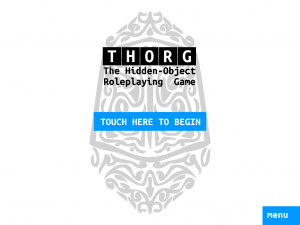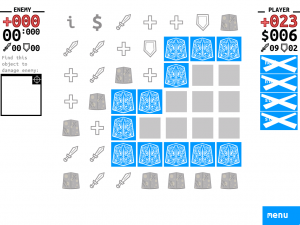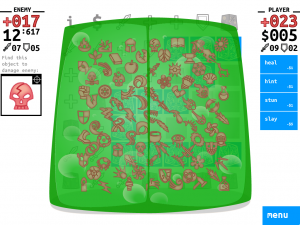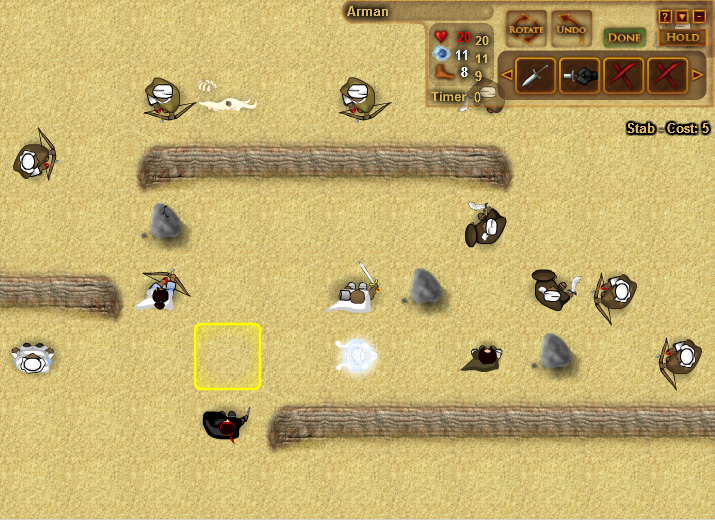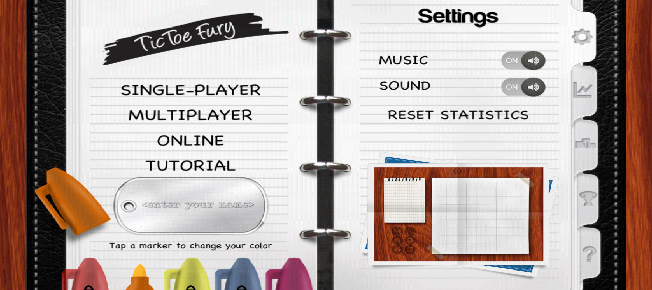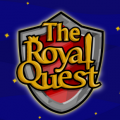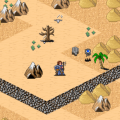Full disclosure: I enlisted my husband, Pablo, for help in this review because he has much more experience playing RPGs than I do. The best parts of this review are his.
_________________________________________________________________________________________
Pablo and I just finished playing THORG: The Hidden-Object Roleplaying Game on our iPads, and while it was fun, we’re left wanting more.
THORG is indie developer Armaan Khan’s attempt to bring new life to the gaming world by combining two usually distinct styles of games into one. Similar to how App Store favorite Sword & Poker is played, which combines classic RPG dungeon crawling with a poker-based card engine to handle battles, THORG changes it up with a hidden object-based battle engine.
When first loading THORG, the user is given a title screen with the instructions, “Touch Here To Begin,” as the only option.
While there is a Menu option available on all screens of the game, choosing it allows you only to adjust sound and music. Missing are familiar options such as Help and About, or a way to be directed to the App Store to rate the game. Even the URL for the developer’s web site is missing. The only URL provided in the game is for A-M Classical, the source for the music.
Help, or even an in-game tutorial for the first battle would benefit someone unfamiliar with hidden object or RPG games. While we were able to pick up what to do pretty quickly, less experienced gamers may become frustrated and give up. A little work here could really add a professional look and feel to the game, as well as help the author self-advertise to people who already enjoy the game.
As for the game itself, you are provided with a 7×7 grid containing one blue square. On the left is the generically named “Enemy” and on the right is the equally generic “Player”. Typical RPGs let you name your player, helping you engage with the game. Named enemies would be something we’d like to see, too. For a dungeon crawling style RPG, half the fun is finding crazy enemies to fight.
Below the Enemy and Player are statistics that aren’t entirely clear until you play the game a few times.
You’re not told what to do at this point and have to figure out that to begin, you tap the blue square. Then you receive the only real instructions the game provides, “Explore. Collect. Fight. Survive. (Last One Optional). Touch to begin.”
When you’re returned to the main screen, the blue square now displays an “i”. (We think this means “I” as in the player, but it’s lower case which usually denotes “information”. However, tapping it does nothing.) The four squares above, below, right and left of the “i” are now blue. These are your next options.
The object of the game is to explore this 7×7 grid. If you uncover all 49 squares, you win. We’re not sure what we’re searching through, however. It’s a grid reminiscent of minesweeper, but missing the strategy. Is this supposed to be a castle? A forest? Mount Mordor? Adding some graphics or a map so it looks like the player is searching a desert or dungeon would create a more fantasy-like environment. Perhaps even a simple story to base it around. “You come across a blacksmith and he offers to make you a sword. Attack +1 …”
Each blue square you tap uncovers one of four things: attack, defense, money and battles. Uncovering any of the first three things does exactly what is expected, you get more attack power, defense power or money, and you can see that reflected under the player stats. The fourth brings up a battle screen that says, “An Enemy Approaches!”
Here is where the game goes from an RPG to a hidden object game. Hidden object games usually consist of a picture and a list of items you’re instructed to find within that picture, but THORG is not your typical RPG or your typical hidden object game. Instead a screen of about 100 objects is displayed. When the battle begins you are instructed to locate one specific object among the others and you need to do this as quickly as possible.
The enemy’s time is set to 15 seconds and starts counting down when the battle begins. If you don’t find the object before it reaches zero, you will incur damage. This appears to be based on the Enemy attack hit points and Player defense hit points. As the game proceeds, your attack and defense will go up, however the Enemy’s seems to go up at the same rate as yours. So, if you find lots of attack and defense early on the grid, you won’t be more powerful–the Enemy seems to adjust with you. The only thing that appears to change as you progress is the number of hit points the Enemy starts with.
The key to the game is using the power ups, Heal, Hint, Stun, and Slay. These are four options that appear under the Player. They are initially crossed out but when a battle begins, they become available. Heal with restore five hit points, Hint will show you the area of the screen the object you are looking for is in, Stun will stop the timer until you tap the screen again, and Slay wins the battle.
Each of these options has a price tag and this makes money very important to being able to complete the grid. Later battles will have enemies that do more damage and the timer decreases a bit as the game progresses.
That’s basically it. When you find the object, you “hit” the Enemy. If you take too long, the enemy “hits” you. Whoever gets their opponent to zero hit points first wins the battle. Win the battle and you can keep exploring the grid, lose it, and you have to start over.
While the developer claims, “the game is not about winning or losing, just about playing”, there is a timer that turns the casual exercise of finding an object into a stressful one. We understand why he cannot remove the timer, as the battle is based on it, but if the game continues to develop into something larger, we could see a practice mode for beginners with no timer, or maybe with extra hit points, being a nice feature.
And of course, some instruction or tutorial. Successful games should appeal to all levels of players and it seems the author is trying to be minimalist by leaving these things out out, claiming the game to be simple enough to play without any instruction. But rather than sleek and Applesque, unless the player searched out the author’s blog for this explanation, this design idea could appear to be lazy development or worse, result in someone believing a feature is missing.
All in all, we both enjoyed THORG‘s fresh take on traditional RPGs. It’s an interesting first start and we’re both excited to see where it goes.
Overall Rating: 




This game was reviewed using a copy of the game provided by the developer for that purpose.
© 2012 – 2013, The Indie Mine. All rights reserved.

